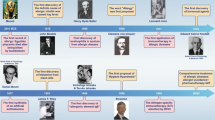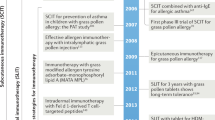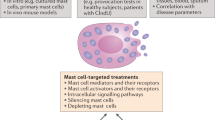Abstract
Allergic disorders, such as anaphylaxis, hay fever, eczema and asthma, now afflict roughly 25% of people in the developed world. In allergic subjects, persistent or repetitive exposure to allergens, which typically are intrinsically innocuous substances common in the environment, results in chronic allergic inflammation. This in turn produces long-term changes in the structure of the affected organs and substantial abnormalities in their function. It is therefore important to understand the characteristics and consequences of acute and chronic allergic inflammation, and in particular to explore how mast cells can contribute to several features of this maladaptive pattern of immunological reactivity.
This is a preview of subscription content, access via your institution
Access options
Subscribe to this journal
Receive 51 print issues and online access
$199.00 per year
only $3.90 per issue
Buy this article
- Purchase on Springer Link
- Instant access to full article PDF
Prices may be subject to local taxes which are calculated during checkout






Similar content being viewed by others
References
von Pirquet, C. Allergie. Münch. Med. Wochenschr. 53, 1457–1458 (1906).
Silverstein, A. M. Clemens Freiherr von Pirquet: explaining immune complex disease in 1906. Nature Immunol. 1, 453–455 (2000).
Holgate, S. T. The epidemic of allergy and asthma. Nature 402, B2–B4 (1999).
Kay, A. B. Allergy and allergic diseases. First of two parts. N. Engl. J. Med. 344, 30–37 (2001).
Eder, W., Ege, M. J. & von Mutius, E. The asthma epidemic. N. Engl. J. Med. 355, 2226–2235 (2006).
Sampson, H. A. et al. Symposium on the definition and management of anaphylaxis: summary report. J. Allergy Clin. Immunol. 115, 584–591 (2005).
Barnes, P. J. New therapies for asthma. Trends Mol. Med. 12, 515–520 (2006).
Kraft, S. & Kinet, J. P. New developments in FcɛRI regulation, function and inhibition. Nature Rev. Immunol. 7, 365–378 (2007). This review of FcɛRI-dependent signalling in mast cells and basophils considers how the biology and functional properties of FcɛRI might be exploited for the development of new therapeutics.
Holgate, S. T. & Polosa, R. Treatment strategies for allergy and asthma. Nature Rev. Immunol. 8, 218–230 (2008).
Larché, M., Akdis, C. A. & Valenta, R. Immunological mechanisms of allergen-specific immunotherapy. Nature Rev. Immunol. 6, 761–771 (2006). This review discusses the history, immunological mechanisms and future prospects of improving allergen-specific immunotherapy.
Akdis, M. & Akdis, C. A. Mechanisms of allergen-specific immunotherapy. J. Allergy Clin. Immunol. 119, 780–791 (2007).
Kukkonen, K. et al. Probiotics and prebiotic galacto-oligosaccharides in the prevention of allergic diseases: a randomized, double-blind, placebo-controlled trial. J. Allergy Clin. Immunol. 119, 192–198 (2007).
Yazdanbakhsh, M., Kremsner, P. G. & van Ree, R. Allergy, parasites, and the hygiene hypothesis. Science 296, 490–494 (2002).
Galli, S. J. & Askenase, P. W. in The Reticuloendothelial System: A Comprehensive Treatise Vol. IX: Hypersensitivity (eds Abramoff, P., Phillips, S. M. & Escobar, M. R.) 321–369 (Plenum, 1986).
Fallon, P. G. & Mangan, N. E. Suppression of TH2-type allergic reactions by helminth infection. Nature Rev. Immunol. 7, 220–230 (2007).
Hawrylowicz, C. M. & O'Garra, A. Potential role of interleukin-10-secreting regulatory T cells in allergy and asthma. Nature Rev. Immunol. 5, 271–283 (2005). This review provides an introduction to the mechanisms by which regulatory T cells that produce the anti-inflammatory and immunosuppressive cytokine IL-10 might limit the pathology associated with allergy and allergic inflammation of the airways in asthma.
Romagnani, S. Coming back to a missing immune deviation as the main explanatory mechanism for the hygiene hypothesis. J. Allergy Clin. Immunol. 119, 1511–1513 (2007).
Cookson, W. The immunogenetics of asthma and eczema: a new focus on the epithelium. Nature Rev. Immunol. 4, 978–988 (2004).
Vercelli, D. Discovering susceptibility genes for asthma and allergy. Nature Rev. Immunol. 8, 169–182 (2008). This review presents the current understanding of the many genes that have been implicated in asthma and allergy, including evidence that exposure to the same microbial products may have opposite effects on susceptibility to developing allergic disorders, depending on an individual's genotype.
Geha, R. S., Jabara, H. H. & Brodeur, S. R. The regulation of immunoglobulin E class-switch recombination. Nature Rev. Immunol. 3, 721–732 (2003).
Gould, H. J. & Sutton, B. J. IgE in allergy and asthma today. Nature Rev. Immunol. 8, 205–217 (2008). This review describes the complex role of IgE and its receptors in allergy and asthma, including evidence that IgE and its receptors may contribute to epitope spreading in, and therefore exacerbation of, allergic disorders.
Herrick, C. A. & Bottomly, K. To respond or not to respond: T cells in allergic asthma. Nature Rev. Immunol. 3, 405–412 (2003).
Dickey, B. F. Exoskeletons and exhalation. N. Engl. J. Med. 357, 2082–2084 (2007).
Saxon, A. & Diaz-Sanchez, D. Air pollution and allergy: you are what you breathe. Nature Immunol. 6, 223–226 (2005).
Hammad, H. & Lambrecht, B. N. Dendritic cells and epithelial cells: linking innate and adaptive immunity in asthma. Nature Rev. Immunol. 8, 193–204 (2008).
Platts-Mills, T. A., Woodfolk, J. A., Erwin, E. A. & Aalberse, R. Mechanisms of tolerance to inhalant allergens: the relevance of a modified TH2 response to allergens from domestic animals. Springer Semin. Immunopathol. 25, 271–279 (2004).
Sandilands, A., Smith, F. J., Irvine, A. D. & McLean, W. H. Filaggrin's fuller figure: a glimpse into the genetic architecture of atopic dermatitis. J. Invest. Dermatol. 127, 1282–1284 (2007).
Schleimer, R. P., Kato, A., Kern, R., Kuperman, D. & Avila, P. C. Epithelium: at the interface of innate and adaptive immune responses. J. Allergy Clin. Immunol. 120, 1279–1284 (2007).
Ying, S., Meng, Q., Corrigan, C. J. & Lee, T. H. Lack of filaggrin expression in the human bronchial mucosa. J. Allergy Clin. Immunol. 118, 1386–1388 (2006).
Jeong, S. K. et al. Mite and cockroach allergens activate protease-activated receptor 2 and delay epidermal permeability barrier recovery. J. Invest. Dermatol. 128, 1930–1939 (2008).
McKerrow, J. H., Caffrey, C., Kelly, B., Loke, P. & Sajid, M. Proteases in parasitic diseases. Annu. Rev. Pathol. 1, 497–536 (2006).
Min, B. & Paul, W. E. Basophils: in the spotlight at last. Nature Immunol. 9, 223–225 (2008).
Sokol, C. L., Barton, G. M., Farr, A. G. & Medzhitov, R. A mechanism for the initiation of allergen-induced T helper type 2 responses. Nature Immunol. 9, 310–318 (2008). This paper identifies a key role for basophils in the initiation of T H 2-cell responses to exogenous proteases.
Marshall, J. S. Mast-cell responses to pathogens. Nature Rev. Immunol. 4, 787–799 (2004).
Galli, S. J. et al. Mast cells as 'tunable' effector and immunoregulatory cells: recent advances. Annu. Rev. Immunol. 23, 749–786 (2005). This review discusses many aspects of mast-cell biology, including mast-cell phenotypic heterogeneity and function, and the roles of mast cells as effector and potential immunoregulatory cells in innate and adaptive immune responses.
Gilfillan, A. M. & Tkaczyk, C. Integrated signalling pathways for mast-cell activation. Nature Rev. Immunol. 6, 218–230 (2006).
Rivera, J. & Gilfillan, A. M. Molecular regulation of mast cell activation. J. Allergy Clin. Immunol. 117, 1214–1225 (2006).
Dvorak, A. M. Ultrastructural studies of human basophils and mast cells. J. Histochem. Cytochem. 53, 1043–1070 (2005).
Caughey, G. H. Mast cell tryptases and chymases in inflammation and host defense. Immunol. Rev. 217, 141–154 (2007).
Pejler, G., Abrink, M., Ringvall, M. & Wernersson, S. Mast cell proteases. Adv. Immunol. 95, 167–255 (2007).
Stevens, R. L. & Adachi, R. Protease-proteoglycan complexes of mouse and human mast cells and importance of their beta-tryptase-heparin complexes in inflammation and innate immunity. Immunol. Rev. 217, 155–167 (2007).
Bradding, P. & Holgate, S. T. The mast cell as a source of cytokines in asthma. Ann. NY Acad. Sci. 796, 272–281 (1996).
Saito, H., Nakajima, T. & Matsumoto, K. Human mast cell transcriptome project. Int. Arch. Allergy Immunol. 125, 1–8 (2001).
Boyce, J. A. Mast cells and eicosanoid mediators: a system of reciprocal paracrine and autocrine regulation. Immunol. Rev. 217, 168–185 (2007).
Finkelman, F. D. Anaphylaxis: lessons from mouse models. J. Allergy Clin. Immunol. 120, 506–515 (2007).
Wills-Karp, M. Immunologic basis of antigen-induced airway hyperresponsiveness. Annu. Rev. Immunol. 17, 255–281 (1999).
Sarin, S., Undem, B., Sanico, A. & Togias, A. The role of the nervous system in rhinitis. J. Allergy Clin. Immunol. 118, 999–1016 (2006).
Cevikbas, F., Steinhoff, A., Homey, B. & Steinhoff, M. Neuroimmune interactions in allergic skin diseases. Curr. Opin. Allergy Clin. Immunol. 7, 365–373 (2007).
Lalloo, U. G., Barnes, P. J. & Chung, K. F. Pathophysiology and clinical presentations of cough. J. Allergy Clin. Immunol. 98, S91–S96; discussion S96–S97 (1996).
MacGlashan, D. Jr, Gauvreau, G. & Schroeder, J. T. Basophils in airway disease. Curr. Allergy Asthma Rep. 2, 126–132 (2002).
Marone, G., Triggiani, M. & de Paulis, A. Mast cells and basophils: friends as well as foes in bronchial asthma? Trends Immunol. 26, 25–31 (2005).
Galli, S. J., Grimbaldeston, M. A. & Tsai, M. Immunomodulatory mast cells: negative, as well as positive, regulators of immunity. Nature Rev. Immunol. 8, 478–486 (2008).
Sayed, B. A., Christy, A., Quirion, M. R. & Brown, M. A. The master switch: the role of mast cells in autoimmunity and tolerance. Annu. Rev. Immunol. 26, 705–739 (2008).
Bradding, P., Walls, A. F. & Holgate, S. T. The role of the mast cell in the pathophysiology of asthma. J. Allergy Clin. Immunol. 117, 1277–1284 (2006).
Brown, J. M., Wilson, T. M. & Metcalfe, D. D. The mast cell and allergic diseases: role in pathogenesis and implications for therapy. Clin. Exp. Allergy 38, 4–18 (2008).
Larché, M., Robinson, D. S. & Kay, A. B. The role of T lymphocytes in the pathogenesis of asthma. J. Allergy Clin. Immunol. 111, 450–463 (2003).
Kay, A. B. et al. Airway expression of calcitonin gene-related peptide in T-cell peptide-induced late asthmatic reactions in atopics. Allergy 62, 495–503 (2007).
Bonness, S. & Bieber, T. Molecular basis of atopic dermatitis. Curr. Opin. Allergy Clin. Immunol. 7, 382–386 (2007).
Doherty, T. & Broide, D. Cytokines and growth factors in airway remodeling in asthma. Curr. Opin. Immunol. 19, 676–680 (2007).
Holgate, S. T. Epithelium dysfunction in asthma. J. Allergy Clin. Immunol. 120, 1233–1244 (2007). This review discusses the role of the airway epithelium and its function (and dysfunction) in the development and pathology of asthma.
Mauad, T., Bel, E. H. & Sterk, P. J. Asthma therapy and airway remodeling. J. Allergy Clin. Immunol. 120, 997–1009 (2007).
Ollerenshaw, S. L., Jarvis, D., Sullivan, C. E. & Woolcock, A. J. Substance P immunoreactive nerves in airways from asthmatics and nonasthmatics. Eur. Respir. J. 4, 673–682 (1991).
Chanez, P. et al. Bronchial mucosal immunoreactivity of sensory neuropeptides in severe airway diseases. Am. J. Respir. Crit. Care Med. 158, 985–990 (1998).
Joos, G. F., De Swert, K. O., Schelfhout, V. & Pauwels, R. A. The role of neural inflammation in asthma and chronic obstructive pulmonary disease. Ann. NY Acad. Sci. 992, 218–230 (2003).
Lewis, M. J., Short, A. L. & Lewis, K. E. Autonomic nervous system control of the cardiovascular and respiratory systems in asthma. Respir. Med. 100, 1688–1705 (2006).
Brightling, C. E. et al. Mast-cell infiltration of airway smooth muscle in asthma. N. Engl. J. Med. 346, 1699–1705 (2002).
Cohn, L., Elias, J. A. & Chupp, G. L. Asthma: mechanisms of disease persistence and progression. Annu. Rev. Immunol. 22, 789–815 (2004).
Gern, J. E. & Busse, W. W. Relationship of viral infections to wheezing illnesses and asthma. Nature Rev. Immunol. 2, 132–138 (2002).
Leung, D. Y., Boguniewicz, M., Howell, M. D., Nomura, I. & Hamid, Q. A. New insights into atopic dermatitis. J. Clin. Invest. 113, 651–657 (2004).
Pawankar, R., Nonaka, M., Yamagishi, S. & Yagi, T. Pathophysiologic mechanisms of chronic rhinosinusitis. Immunol. Allergy Clin. North Am. 24, 75–85 (2004).
Takano, K. et al. HLA-DR- and CD11c-positive dendritic cells penetrate beyond well-developed epithelial tight junctions in human nasal mucosa of allergic rhinitis. J. Histochem. Cytochem. 53, 611–619 (2005).
Spergel, J. M. & Paller, A. S. Atopic dermatitis and the atopic march. J. Allergy Clin. Immunol. 112, S118–S127 (2003).
Barnes, P. J. Immunology of asthma and chronic obstructive pulmonary disease. Nature Rev. Immunol. 8, 183–192 (2008).
Kawakami, T. & Galli, S. J. Regulation of mast-cell and basophil function and survival by IgE. Nature Rev. Immunol. 2, 773–786 (2002).
Yu, M. et al. Mast cells can promote the development of multiple features of chronic asthma in mice. J. Clin. Invest. 116, 1633–1641 (2006). This paper presents evidence that mast cells can contribute to multiple features of the pathology in a mouse model of chronic asthma both by mechanisms that do or do not require the antibody (IgE and/or IgG1)-dependent activation of mast cells through the FcRγ chain shared by mast-cell FcɛRI and FcγRIII.
Jacobsen, E. A. et al. Allergic pulmonary inflammation in mice is dependent on eosinophil-induced recruitment of effector T cells. J. Exp. Med. 205, 699–710 (2008).
Peters-Golden, M. The alveolar macrophage: the forgotten cell in asthma. Am. J. Respir. Cell Mol. Biol. 31, 3–7 (2004).
Kasperska-Zajac, A. & Rogala, B. Platelet activation during allergic inflammation. Inflammation 30, 161–166 (2007).
Akbari, O. et al. CD4+ invariant T-cell-receptor+ natural killer T cells in bronchial asthma. N. Engl. J. Med. 354, 1117–1129 (2006).
Vijayanand, P. et al. Invariant natural killer T cells in asthma and chronic obstructive pulmonary disease. N. Engl. J. Med. 356, 1410–1422 (2007).
Holgate, S. T., Djukanovic, R., Casale, T. & Bousquet, J. Anti-immunoglobulin E treatment with omalizumab in allergic diseases: an update on anti-inflammatory activity and clinical efficacy. Clin. Exp. Allergy 35, 408–416 (2005).
Casale, T. B. et al. Effect of omalizumab on symptoms of seasonal allergic rhinitis: a randomized controlled trial. J. Am. Med. Assoc. 286, 2956–2967 (2001).
Leung, D. Y. et al. Effect of anti-IgE therapy in patients with peanut allergy. N. Engl. J. Med. 348, 986–993 (2003).
Akdis, C. A., Blaser, K. & Akdis, M. Apoptosis in tissue inflammation and allergic disease. Curr. Opin. Immunol. 16, 717–723 (2004).
Ryan, J. J. et al. Mast cell homeostasis: a fundamental aspect of allergic disease. Crit. Rev. Immunol. 27, 15–32 (2007).
Medoff, B. D., Thomas, S. Y. & Luster, A. D. T cell trafficking in allergic asthma: the ins and outs. Annu. Rev. Immunol. 26, 205–232 (2008). This is a comprehensive review of the molecular regulation and consequences of T-cell migration in allergic inflammation of airways.
Grimbaldeston, M. A., Nakae, S., Kalesnikoff, J., Tsai, M. & Galli, S. J. Mast cell-derived interleukin 10 limits skin pathology in contact dermatitis and chronic irradiation with ultraviolet B. Nature Immunol. 8, 1095–1104 (2007).
Serhan, C. N., Yacoubian, S. & Yang, R. Anti-inflammatory and proresolving lipid mediators. Annu. Rev. Pathol. 3, 279–312 (2008).
Opal, S. M. & DePalo, V. A. Anti-inflammatory cytokines. Chest 117, 1162–1172 (2000).
Letterio, J. J. & Roberts, A. B. Regulation of immune responses by TGF-β. Annu. Rev. Immunol. 16, 137–161 (1998).
Li, M. O. & Flavell, R. A. Contextual regulation of inflammation: a duet by transforming growth factor-β and interleukin-10. Immunity 28, 468–476 (2008).
Burgel, P. R. et al. Human eosinophils induce mucin production in airway epithelial cells via epidermal growth factor receptor activation. J. Immunol. 167, 5948–5954 (2001).
Vignali, D. A. A., Collison, L. W. & Workman, C. J. How regulatory T cells work. Nature Rev. Immunol. 8, 523–532 (2008).
Hall, I. P. & Sayers, I. Pharmacogenetics and asthma: false hope or new dawn? Eur. Respir. J. 29, 1239–1245 (2007).
Zhu, D. et al. A chimeric human–cat fusion protein blocks cat-induced allergy. Nature Med. 11, 446–449 (2005).
Lack, G., Fox, D., Northstone, K. & Golding, J. Factors associated with the development of peanut allergy in childhood. N. Engl. J. Med. 348, 977–985 (2003).
Platts-Mills, T. A., Vervloet, D., Thomas, W. R., Aalberse, R. C. & Chapman, M. D. Indoor allergens and asthma: report of the Third International Workshop. J. Allergy Clin. Immunol. 100, S2–S24 (1997).
Ownby, D. R. & Johnson, C. C. Does exposure to dogs and cats in the first year of life influence the development of allergic sensitization? Curr. Opin. Allergy Clin. Immunol. 3, 517–522 (2003).
Lucas, S. R. & Platts-Mills, T. A. Physical activity and exercise in asthma: relevance to etiology and treatment. J. Allergy Clin. Immunol. 115, 928–934 (2005).
Acknowledgements
We thank G. Berry and J. Kalesnikoff for help with the figures, C. M. Hawrylowicz and members of the Galli laboratory for critical reading of the manuscript, and the National Institutes of Health for financial support.
Author information
Authors and Affiliations
Ethics declarations
Competing interests
S.J.G. is occasionally a consultant for Genentech and Novartis, which produce omalizumab (an anti-asthma therapeutic that is mentioned in this Review). S.J.G. is also on the Scientific Advisory Board of Tunitas Therapeutics, which hopes to develop products for treating allergies and asthma.
Additional information
Reprints and permissions information is available at http://www.nature.com/reprints.
Correspondence should be addressed to S.J.G. (sgalli@stanford.edu).
Rights and permissions
About this article
Cite this article
Galli, S., Tsai, M. & Piliponsky, A. The development of allergic inflammation. Nature 454, 445–454 (2008). https://doi.org/10.1038/nature07204
Published:
Issue Date:
DOI: https://doi.org/10.1038/nature07204
This article is cited by
-
Incident allergic diseases in post-COVID-19 condition: multinational cohort studies from South Korea, Japan and the UK
Nature Communications (2024)
-
Upregulated expression of Notch1/4 - JAG-1/DLL-1 detected in allergic rhinitis
Allergy, Asthma & Clinical Immunology (2023)
-
Feline heartworm disease and environmental allergens hypersensitivity: is there a link?
Parasites & Vectors (2023)
-
Human placental extract suppresses mast cell activation and induces mast cell apoptosis
Allergy, Asthma & Clinical Immunology (2023)
-
Airway and parenchyma transcriptomics in a house dust mite model of experimental asthma
Respiratory Research (2023)
Comments
By submitting a comment you agree to abide by our Terms and Community Guidelines. If you find something abusive or that does not comply with our terms or guidelines please flag it as inappropriate.



